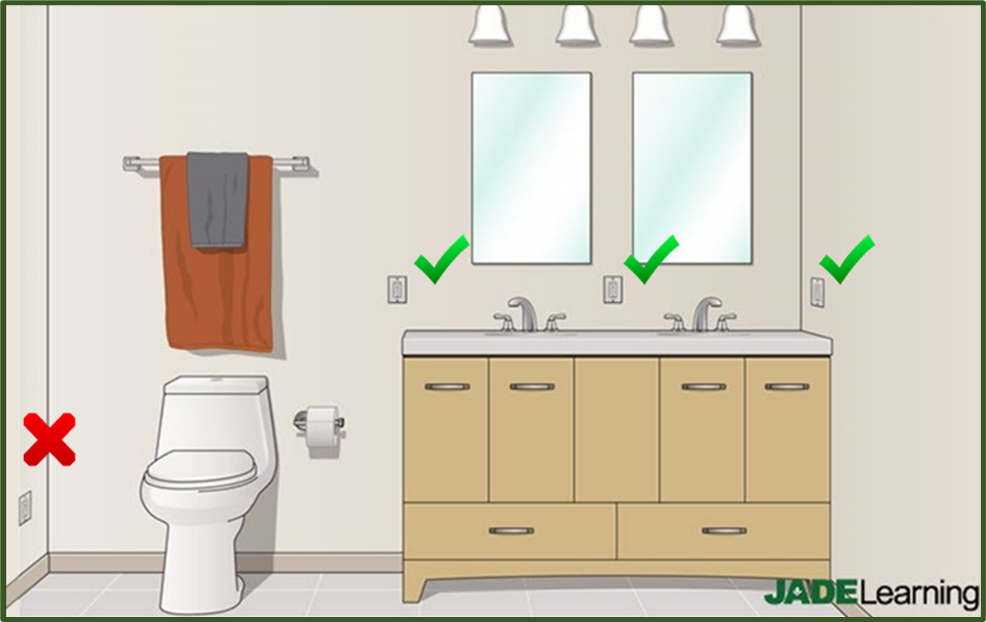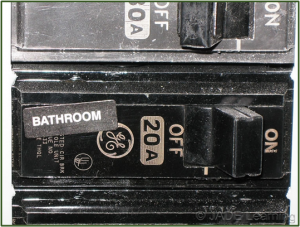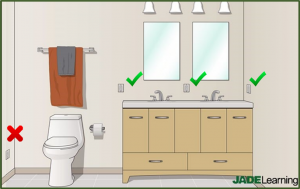Bathroom Branch Circuits in the 2020 NEC
Published on January 6, 2021 by Jerry Durham

Section 210.11(C)(3) and the changes you must know
Bathroom branch circuit requirements have changed for the 2020 Code cycle. The one 20-amp branch circuit traditionally required by NEC Section 210.11(C)(3) to feed only receptacles in dwelling unit bathroom(s) is now restricted to feeding only countertop receptacles in those same bathroom(s).
The receptacles permitted on this newly defined branch circuit include any countertop receptacles required to be within 3 feet of the bathroom's sink basin and any other receptacle(s) installed to serve countertops or similar work surfaces in these bathroom(s).
In the 2020 NEC, feeding receptacles located elsewhere in the bathroom with the branch circuit required in Section 210.11(C)(3), is no longer permitted.

2017 NEC vs 2020 NEC — Section 210.11(C)(3)
2017 NEC
In the 2017 Code cycle, the electrician was permitted to use the one 20-amp branch circuit required in Section 210.11(C)(3) to feed all receptacles located in all bathrooms of the home. If the home was equipped with one bathroom containing a countertop receptacle to serve the sink area, and two more receptacles located near the floor on the opposite wall, then the 20-amp branch circuit specified in 210.11(C)(3) could feed all three of these receptacles. If the homeowner had three of these bathrooms and all were of similar design, the 20-amp branch circuit could feed all nine receptacles.
In sum, regardless of the number of bathrooms in the home, the one 20-amp branch circuit required in 210.11(C)(3) could feed all their combined receptacles.
2020 NEC
In the new 2020 Code cycle, the electrician is restricted to using the one 20-amp branch circuit required in Section 210.11(C)(3) to feed only countertop and similar work surface receptacles in these dwelling unit bathroom(s). The one 20-amp branch circuit can still feed all the bathrooms in the home, but it is limited to supplying only the receptacles that serve countertops and work surfaces in these bathrooms. All other bathroom receptacles are off-limits.

In the 2020 NEC, the one 20-amp branch circuit required for bathrooms can only feed receptacles serving countertops and similar work surfaces in these bathrooms.
The Exception — What Has Not Changed for the 2020 Code Cycle
The following remains the same for the 2020 Code cycle; these requirements were part of the Code in the 2017 edition of the NEC:
- If the electrician feeds only a single bathroom with the one 20-amp branch circuit required in 210.11(C)(3), then the electrician may feed loads other than countertop and work surface receptacles in that bathroom. The NEC offers no restrictions for the types of additional loads that can be served in this case. Assuming the electrician is complying with all manufacturer's specifications for the equipment installed in the bathroom, it is fair to say that all 120-Volt receptacles and loads, including lighting, can be served by this branch circuit when it is dedicated to a single bathroom.
- It is always permissible to pull more than one 20-amp branch circuit for feeding the bathrooms in a dwelling. One branch circuit is simply the minimum permitted for a dwelling regardless of the number of bathrooms.
- The electrician is still required to install one countertop receptacle within 3 feet of the outside edge of each bathroom sink basin.
Conclusion
The revision found in Section 210.11(C)(3) for the 2020 Code cycle makes good sense. If we refer to the previous example of three bathrooms, each with three receptacles, under the 2017 edition of this Code, we would end up with nine receptacles on one 20-amp branch circuit. Since wall receptacles installed near the floor of a bathroom are often used for powering portable space heaters, it is logical to take these- and all other receptacles not serving the countertop(s)- off of this single branch circuit.
The electrician is still allowed the opportunity to cut costs by feeding multiple bathrooms with one 20-amp branch circuit- just not at the expense of what is reasonable.
